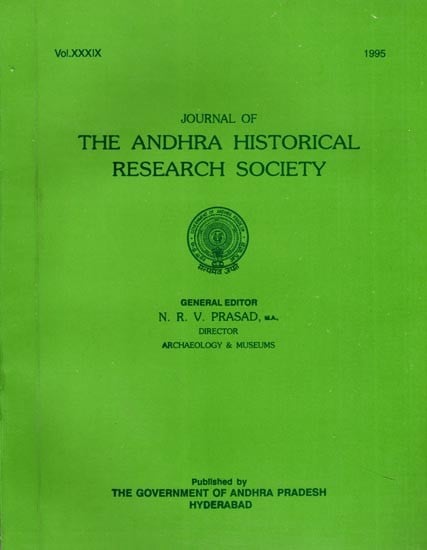
| Specifications |
| Publisher: The Government Of Andhra Pradesh, Hyderabad | |
| Author Edited By N. R. V. Prasad | |
| Language: English | |
| Pages: 238 (With B/W Illustrations) | |
| Cover: PAPERBACK | |
| 11x9 inch | |
| Weight 630 gm | |
| Edition: 1995 | |
| HBE082 |
| Delivery and Return Policies |
| Usually ships in 12 days | |
| Returns and Exchanges accepted within 7 days | |
| Free Delivery |
I am happy to place before the scholar-historians, the 30th Number of The Journal of Andhra Historical Research Society, inspite of the inervitable delay. This is partly due to the non-availability of printing facility in the Government Presses and partly due to the non-avallability of Dr.K.Krishna Murthy, who was entrusted with the task of editing, owing to -health. However, I seek the indulgence of the scholars who contributed their papers in particular, to bear with the department for the delay. Keeping up the onerous responsibility and commitment to continue the journal, we have undertaken the printing of this voume by including several valuable research articles. The present volume comprises of 30 articles and a book-review, written by well-known scholars and historians of national and international repute like Sri C.Sivarama Murthy, Dr.K.Krishna Murthy, Dr.K.N.Prasad, Dr.P.V.P.Sastry etc., dealing with various aspects of historical research based on original anthropological, geological and archaeological data. There are also some papers by enthusiastic scholars of the department, reflecting their keen sense of observation and capacity to interpret the recent archaeological finds in a scientific manner. The article entitled "The Occurrence of Rama Pithecus by Dr. K.N.Prasad gives an account of a recently discovered fossil remain called Rama Pithecus, which, according to the scholar, is a precursor to the homo erectus of the early Pliocene times and bridges the gap between the first known Hominid Ramapithecus and Homo erectus of the mid Pliocene times. "Terracotta Coffins in late proto-historic Andhra" by Dr. B.Subrahmanyam and E. Siva Nagi Reddy examines the occurrence of terracotta sarcophagi at a number of megalithic and proto-historic sites in Andhra Pradesh like Janampet, Sankhavaram, Peddamarur, Eleswaram, Jonnavada, Irladinne, Kadambapur, Agiripalle and Tenner with special reference to the practice of keeping sarcophagi in burials, and examines whether the practice was Indigenous or borrowed from outside like Mesopotamia, where such coffins are reported as early as 3,000 B.C. They have also examined whether the practice is universal to the megalithic folk or limited to a particular tribe of any religioeschatological beliefs if any, behind keeping such coffins.
There are two articles based on literary works, one of them dealing with the noble qualities possessed by the king Mandhata, who occupied a unique place in both Brahmanical and Buddhist lore as well and is a study of the sculptural representations of Mandhata Jataka carved on upright slabs at Amaravati and Nagarjunakonda. Similarly the other deals with the concept, education and training to be received by a king and his daily routine etc. as found in the Kamandaka Nitisara, a work on polity le. Rajaniti, which again is based on Kautilya's Artha Sastra. Among the others, the article of Late Sri B.S.L.Hanumantharao "Asoka-Maurya Chief Royal Patron of Buddhism in Andhra", dwells at length the yeoman services rendered by the illustrious monarch for the propagation of Buddhism in Andhra and even attempts to identify the Stupas at Salihundam, Guntupalle and Amaravati, as those built by Asoka, based on contemporary epigraphical, architectural and sculptural evidences.
Besides the above, there are two papers by Dr.K.Krishna Murthy entitled "Monolithic Sculptures from the vicinity of Vemanapalle(v), Adilabad District and Palliswara Mudaiya Madeva temple at Kalukada(v), in Chittoor District, which form a class by themselves, as they elucidate the typical Iconographical features of the different images and architectural traits of the Valdumbas during the medieval period. Apart from the above, "Erotic Sculptures in Orissan Temples by Sri R.C.Misra, discusses at length the various theories for the exuberant erotic sculptures in the temple architecture of Orissa. Two other articles explaining the antiquity and significance of the place names like Visakhapatnam in Andhra Pradesh and Nandinagar in Madhya Pradesh draw evidence from archaeological excavations and Buddhist literature. The other articles dealing with various aspects like "Vimanas in Vijayanagara temples, Agrarian relations in A.P. during the medieval period, Causes for the fall of Kakatiyas and a Unique Varaha Sculpture from Panagal," are also interesting.
In the end, I wish to thank all the scholars for contributing their valuable articles. I also thank Dr.N.S.Ramachandra Murthy, Assistant Director(Publications) and his team of Publication Assistants namely Smt. B.Indumathi Devi, Smt. R.Anjanamani and Sri C.Venkatesam Chetty for their whole-hearted co-operation and assistance in finalising the text. My thanks are also due to M/s Swamy Graphics for printing the above publication in a neat way and in record time.
Send as free online greeting card

Visual Search